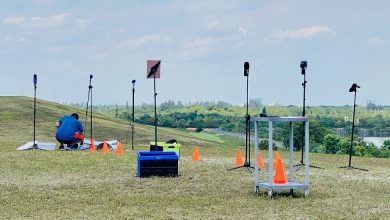Modeling rainfall drop by drop

Using a network of a newly introduced type of rain gauge that can measure rainfall with drop-by-drop precision, KAUST researchers have developed a high-frequency rainfall model to improve understanding of rainfall/runoff dynamics, such as flash flooding and hydrodynamics in small watersheds.
Rainfall modeling is one of the core aspects of weather forecasting and is often used to predict other weather parameters, such as wind and solar irradiance. Yet the power and insight of such models are limited by the data used to construct them. When it comes to precipitation, this means that modelers have to rely on sparse recordings of rainfall at six- to 15-minute intervals at best, but more often hourly intervals. This leads to a “smoothing” of rainfall over time and a loss of information about how much rain falls during each rainfall event, which is a problem, according to Ph.D. student Yuxiao Li.
“This assumption is not appropriate for modeling precipitation at high frequency because large quantities of rainfall in the past can result in an unrealistically high probability of rainfall occurrence in such models,” explains Li. “In this study, we used the high-frequency rainfall data collected by new instruments called Pluvimate rain gauges to better reproduce the statistical properties of precipitation occurrence, intensity and dry-spell duration.”
The new acoustic rain gauges, which record each drop of rain caught in a receptacle, can provide precise high-frequency rainfall data, which are impossible to acquire using classical measurement devices such as tipping-bucket rain gauges and radar. These new datasets provide unprecedented insight into the minute-to-minute dynamics of rainfall, which requires a change in the statistical modeling approach.
“High-frequency precipitation data include more zeros and have longer ‘tails’ to high rainfall intensities than common precipitation data,” says Li. “We developed a model that can capture this ‘skewness’ and the heavy tail of the high-frequency precipitation data, allowing us to generate synthetic precipitation data that provides valuable information for water management, especially at unobserved times and locations.”
The model developed by Li and his supervisor Ying Sun also includes meteorological representations of ground and atmospheric layers, which allows direct physical interpretation of the statistical characteristics.
“Precipitation modeling is one of the main research topics in our Environmental Statistics Group,” says Li. “Our model is the first stochastic precipitation generator for high-frequency precipitation and will be valuable for analyzing many short-term phenomena, as well as forming the basis for a ‘digital twin’ model to reproduce physical processes using a virtual replica, which is a hot topic for smart cities and industry 4.0.”
Conclusion: So above is the Modeling rainfall drop by drop article. Hopefully with this article you can help you in life, always follow and read our good articles on the website: Ngoinhanho101.com




